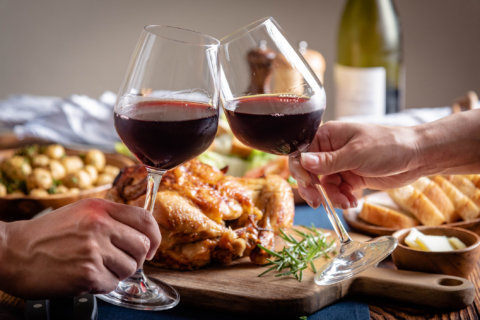The annual Thanksgiving feast can pack a real calorie wallop, but you can employ some strategies to lessen the blow.
Sally Squires, who writes the Lean Plate Club™ blog, told WTOP that people eat an average of 3,000 to 4,500 calories on Thanksgiving. That’s compared with 2,000 calories on a regular day.
That’s a lot, but Squires said it was important to keep that in perspective — “In order to actually put on a pound, you have to consume about 3,500 extra calories.”
She added, “First of all, it’s only one day, so I think none of us need to get too hung up on this one day. It only comes around once a year.”
Still, “you want to be smart about it,” and there are a number of painless ways to do that.
Before the meal
First off, don’t skip breakfast. And if your Thanksgiving dinner is later in the day, don’t skip lunch either. That way, “You’re not munching all day long, or not eating anything and then arriving at your Thanksgiving meal ready to eat everything including the tablecloth,” Squires said.
That said, if you have a choice, you’re better off having the big meal in the middle of the day, she advised. “Then you haven’t been snacking all day long, and you have to time to burn those calories,” after dinner with a family walk, a touch football game or some other kind of activity.
A late dinner invites the temptation to slide from dinner to a football game on TV to bed, and that will help the calories stick to you.
If you’re the one in the kitchen, let’s face it — you eat while you’re cooking.
“It’s a really easy time to eat mindlessly,” Squires said, and there’s no point denying it, so fix yourself a plate of healthy snacks to munch on while you’re putting the dinner together.
It also might be a good idea to make a deal with yourself regarding alcohol.
“Maybe you don’t start imbibing right away,” Squires said, advising that you abstain before dinner, then have a guilt-free glass of wine while you’re eating.
During the meal
A great way to feel full without gorging on calories would be to start with a soup course, Squires said – especially something like a butternut squash or pumpkin soup, which taste creamy without having any actual cream in them.
Squires also said that if you’re going to indulge, concentrate on the holiday-specific foods such as stuffing and maybe pie – not the chips, dips and pigs in a blanket that you can have any time during the year.
And we all know by now to eat slowly, right? Put down your fork between each bite and you’ll feel fuller on fewer calories.
After the meal
“Unless you’re a glutton for punishment” (as opposed to the traditional kind, I guess), Squires advises against getting on the scale Friday morning. You won’t like what it says, and it also won’t tell you anything significant.
“One, you’ve eaten a lot more food than you normally do,” Squires said. “Two, you’ve eaten a lot of salt,” which leads to water retention. The scale will have bad news for you, but, “odds are it’s just water weight and it’s going to go away,” she added. “I’d wait a couple of days and let things settle down.”
Again, she emphasized: It’s once a year, and generally includes family you don’t see much. “This is a wonderful time to gather. It’s important to savor all of that, in addition to the food.”
That said, go back to your usual nutritional routine on Friday: “Don’t use that wonderful day of celebration as a way to celebrate throughout the weekend.”








